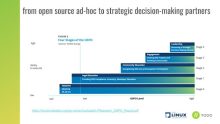It’s not often that I get a chance to join a discussion with other open source leaders to swap insights, share secrets and offer each other tips. This wasn’t a secret invite-only meeting to whisper industry gossip. No, this was a public webinar, “OSPOs in Action: Ways on How Organizations Drive Open Source Innovation,” hosted by the Linux Foundation TODO Group. More than 150 people sat in on our discussion.
Moderated by the TODO Group leaders, Ana Jimenez (Program Manager, TODO Group) and Chris Aniszczyk (CTO, CNCF), the panel included open source industry peers Shilla Saebi (Comcast), Nikita Peters (Porsche) and Alyssa Wright (Bloomberg). The lively panel discussion kicked off with an introduction to OSPOs, their purpose, organizational structure and typical formation. As every company’s needs differ, so too do their OSPOs. According to the TODO Group, an OSPO is defined as the “competency center for an organization’s open source operations and structure.”
At the outset, a company’s OSPO may deal primarily with compliance and consumption. As the organization matures, and the company’s understanding of open source grows more sophisticated, the charter often evolves. According to Aniszczyk, at the most sophisticated, the OSPO can not only foster a company’s expertise, but also help them “participate in upstream communities, develop a deeper engagement, produce code and share projects, and finally, emerge as full blown-leaders … that truly shape the industry.”

TODO Group definition: An open source program office (OSPO) is the center of competency for an organization’s open source operations and structure. This can include establishing code use, distribution, selection, auditing and other policies, as well as training developers, ensuring legal compliance and promoting and building community engagement that benefits the organization strategically.
Each panelist shared their company’s open source journey and how it started and evolved. Though the panelists represented very different industries, a common thread amongst all the panelists quickly emerged: OSPOs can help organizations elevate their open source participation from ad hoc and “accidental” to strategic, holistic and planned. Wright emphasized how an organization must build more “mindfulness around engagement with open source, choosing when to consume, contribute and create.”
The panelists found many points for discussion around challenges, strategies for growth and organizational structure (centralized versus distributed), skills required, operational charter, whether process is a good or a bad thing, and how to temper and where to inject it.
To hear more lessons learned, ideas for implementation and other best practices, listen to the recording of “OSPOs in Action” and then chime in. Does your company have an OSPO? Why or why not? If not, there may be a hidden opportunity for you to unlock even more value from open source in the future.
Stay tuned to the Open Source Blog and follow us on Twitter for more deep dives into the world of open source contributing.





